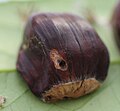| Rusty oak moth | |
|---|---|
 | |
| Scientific classification | |
| Kingdom: | Animalia |
| Phylum: | Arthropoda |
| Class: | Insecta |
| Order: | Lepidoptera |
| Family: | Tortricidae |
| Genus: | Cydia |
| Species: | C. amplana |
| Binomial name | |
| Cydia amplana | |
| Synonyms | |
| |
Cydia amplana, the rusty oak moth, is a moth of the family Tortricidae. It is found from northern, central and southern Europe to Asia Minor, south-western Russia and Transcaucasus. [1]
The wingspan is 16–20 mm. [2] It often needs two years for development. [3]
- Larval exit hole in sweet chestnut


